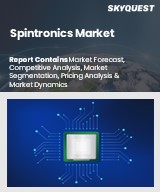
Report ID: SQMIG45N2115
Skyquest Technology's expert advisors have carried out comprehensive research on the spintronics market to identify the major global and regional market trends and growth opportunities for leading players and new entrants in this market. The analysis is based on in-depth primary and secondary research to understand the major market drivers and restraints shaping the future development and growth of the industry.
Growing Demand for Energy-Efficient and High-Performance Memory Solutions
High Manufacturing Costs and Scalability Challenges
Integration Challenges with Conventional CMOS Technologies
REQUEST FOR SAMPLE
Global Spintronics Market size was valued at USD 1.78 Billion in 2023 and is poised to grow from USD 2.07 Billion in 2024 to USD 6.88 Billion by 2032, growing at a CAGR of 16.2% during the forecast period (2025-2032).
The global spintronics market is really driven by companies investing a lot into research and development, along with new tech breakthroughs. Big names like IBM, Intel, and Samsung are all trying to stay ahead by pushing out innovative ideas. For example, IBM has made impressive progress in quantum computing by using spintronic materials to make better qubits, especially by tapping into the quantum spin Hall effect. Likewise, Intel is working on spin-based transistors as part of their long-term plan to bring spintronics into regular computing. These companies are also especially focused on developing spin-based memory solutions like STT-MRAM, which they see as key for automotive tech and AI applications—aiming to lead the way in next-generation memory technologies. Samsung has been channeling investments into spintronic memory and locking in strategic patents to protect their innovations. Partnerships help companies boost their manufacturing capacity, solve issues related to scaling up, and lower the costs of devices. By working together with startups and universities big players are trying to push the limits of what spintronics can do, all while positioning themselves at the forefront of the quantum and AI revolutions. 'IBM Corporation', 'Intel Corporation', 'Everspin Technologies', 'Samsung Electronics', 'NVE Corporation', 'QuantumWise A/S', 'Infineon Technologies AG', 'SpintronicsAI', 'Taiwan Semiconductor Mfg Co Ltd', 'Commissariat Energie Atomique'
What Makes Asia Pacific a Leader in Spintronics?
Want to customize this report? This report can be personalized according to your needs. Our analysts and industry experts will work directly with you to understand your requirements and provide you with customized data in a short amount of time. We offer $1000 worth of FREE customization at the time of purchase.
Feedback From Our Clients

Report ID: SQMIG45N2115
sales@skyquestt.com
USA +1 351-333-4748